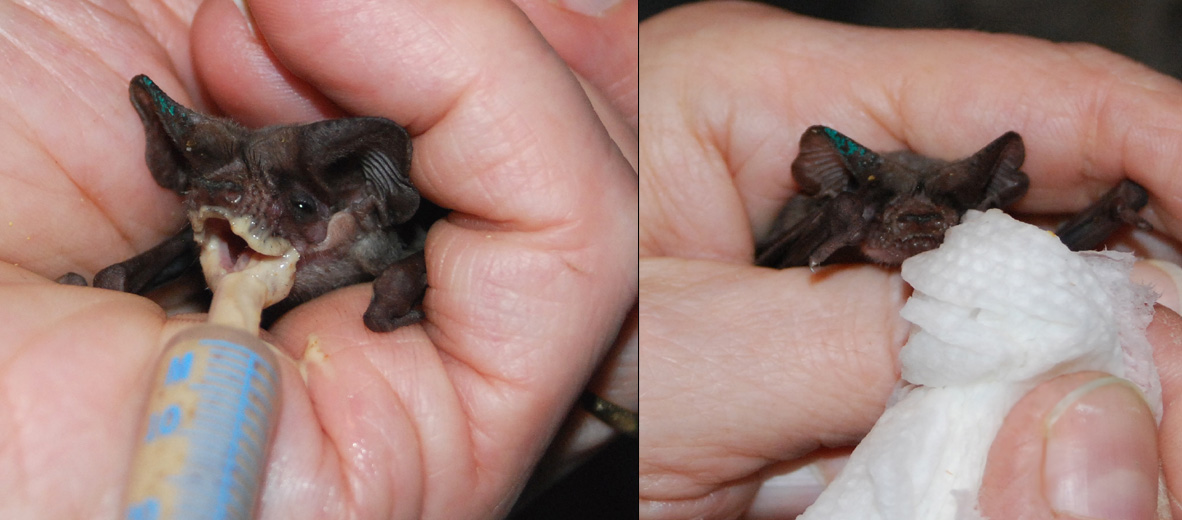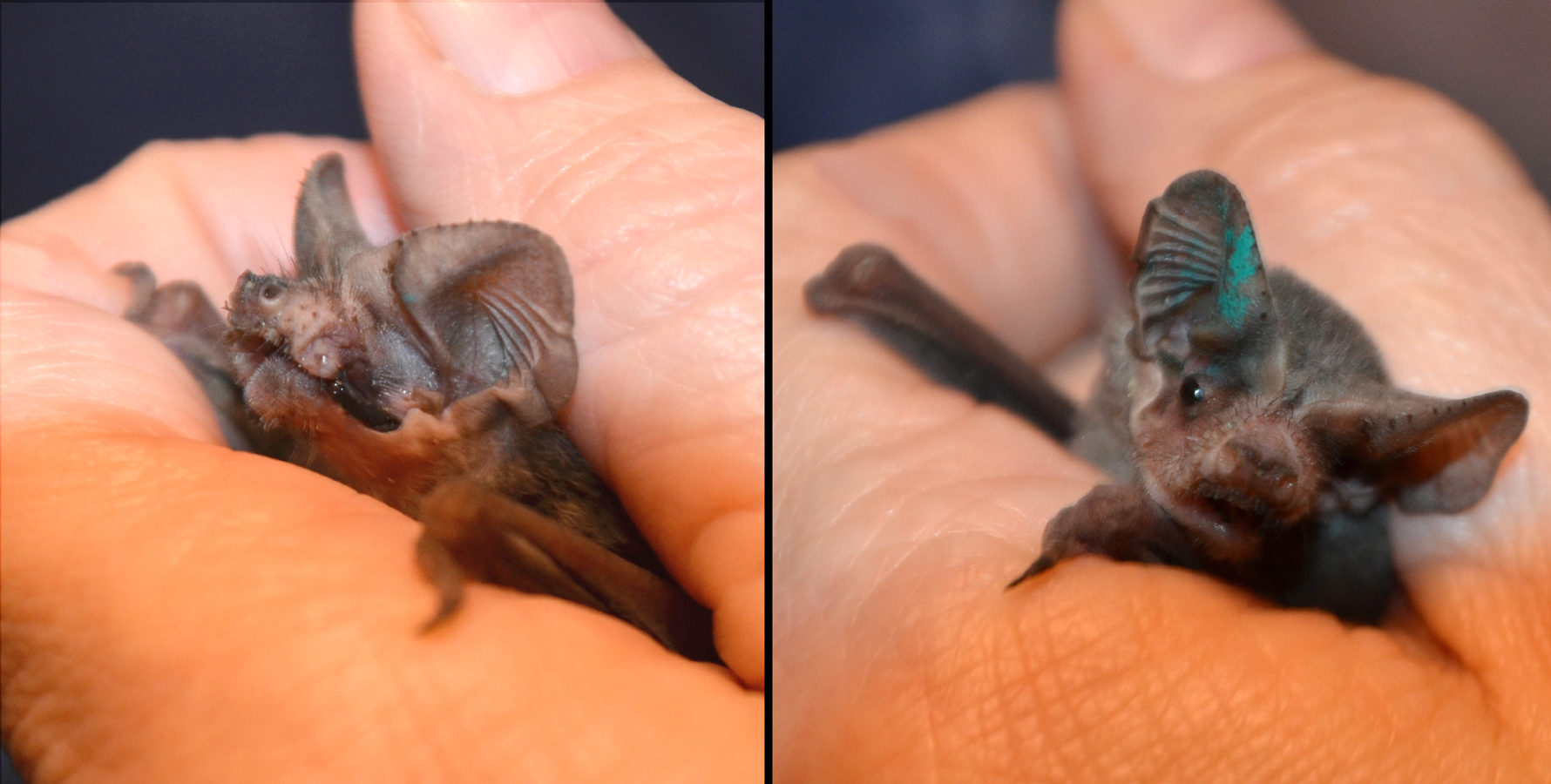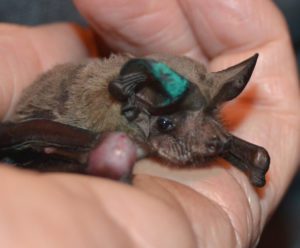Caring for microbats can be very, very different than caring for megabats. The latter can be small, but the former are tiny. Further along that line, for the most part most of these are crevice dwelling bats as opposed to the foliage that fruit bats favor. Crevice dwelling bats know no claustrophobia. In fact, they redefine agoraphobia. When you consider this alongside their diminutive stature, you can see that things might get a little tricky.

As soon as you enter the insect bat enclosure, this is apparent. It might seem as though the native guys – as nearly all of our insect bats are native to this area – are the unfavored stepchildren of Bat World. This, however, isn’t true. No toys hang from the ceiling, but its only because the insect bats would have to come out into the open for extended periods of time to play with them, and it’s just not in their nature to do that. The enclosures also smaller, but so are the bats, as well as the number of them that can actually utilize the flight space. Insect bats really only come to us as rescues in distress of one sort or another, and while nearly all of them are subsequently released after we tend to them, the only ones who stay are those too badly injured or otherwise weakened to return to the wild. As a result, the vast majority of our residents can’t fly at the level of a wild bat, and a great many of those can’t fly at all, so their enclosure is set up so that these bats can traverse its entirety without flapping one wing. More than one only have the one wing to flap as it is, so this is important.
Because of this accessibility, one thing is paramount: safety. The absolute very first thing you must know is that these bats can be anywhere. We’re dealing with highly intelligent animals that can squeeze – with a little difficulty, but they can – through a half- inch wide gap. Not only that, but given their predilection for very enclosed spaces, they enjoy doing so. Tight space is their natural defense. Think of it like a spy choosing a seat at a restaurant so that his back is to the wall and he can see all the exits. Even after he retires, he still chooses the seat at the back because its the only way he feels safe and comfortable. Similarly, a crevice dwelling bat in an open space is invariably a nervous bat and will without fail seek any cover it can find as soon as the opportunity presents itself.
So, the routine: the first thing to do is to start the mealworm sorting process. It’s important, as we hold the same standards for bat food as we do for our own. We order tens of thousands of mealworms at a time, which come packed in grain from a local supplier. Mealworms are the larva of flour beetles. Invariably, a minority of the worms will die off. All will shed their skin as they plump up, and some will even begin to pupate.
The bats don’t like to eat the pupae. Would you? Thus, all this has to be winnowed from the good stuff. But you’re in luck: with a minute of preparation, the mealworms will do it for you. Just sift enough worms from the grain, then place them into the far end of a large bin. Place the smaller bin in the other end of the larger one, then put a big bright fluorescent light over the whole set-up. Mealworms hate light; the smaller bin provides shade. They’ll flock to that shade, leaving the detritus behind. Easy.
Had you worked for a certain institute’s ill-fated assurance colony attempt (their name starts with Smiths- and ends in -onian), you’d have instead spent hours-long shifts plucking viable mealworms out, one-by-one-by -one, with tweezers even though you were trained by Bat World not to do this. You’d also have been wearing a hazmat suit to work with the bats, which is a little like wearing ballistic body armor to a game of golf.

Once the worms are busily turning the concept of survival of the fittest on its head, it’s time to head into the enclosure. Your work primarily concerns the cave, a cabinet designed especially for the bats as well as the caretaker who hand-feeds them.
The basics, as with all bats and all animals in general, are the same. The water and food dishes are much smaller, but need cleaning and refilling as always. The enclosure needs cleaning, although it’s a much easier job than picking/sweeping/mopping after the manically messy fruit bats. Care needs to be taken to disturb the bats as little as possible while all this is done.
All these differences in the insect bats temperament and nature that I’ve pointed out ultimately culminate in the biggest difference between the fruit bat and insect bat routines: the gathering and hand-feeding of those who can’t self-feed. It can seem odd that they simply don’t know how to eat mealworms from a dish, but insect bats eat on the wing, snatching bugs out of the air with the help of echolocation so precise that radar systems around the world tremble with envy. Going from that to a food dish is as easy for them as it is for you to learn how to eat your food only when someone throws it through the air at you. When we get a young bat, there’s a very good chance that they can learn with a little time, but when an older bat comes to us, its more difficult. Some older bats have worn teeth and must be hand-fed soft food for the remainder of their lives, so training isn’t even attempted.
The gathering of the bats coincides with a health check which is performed on every single bat once a day. The bats who need to be hand-fed are marked for easy identification via a green earlobe. The green color is a harmless non-toxic and non-permanent tattoo paste that’s simply smudged onto the ear. Its humane and completely safe, but does need refreshing now and then. All the bats inside the fabric roosting pouches are checked as well as the roosts along the wall of the enclosure, changing roosts out for fresh ones as needed. While performing the daily check, any bats that are to be hand-fed are gathered and placed into a small netted enclosure called a bathut. After the bats are fed they are placed the “Luxury Suite.” The Luxury Suite is a larger, decked-out bathut that includes enrichment. The hand-fed bats will spend the day sleeping inside the luxury suite before being hand-fed again in the evening. After the evening hand-feeding, the bats are placed back into their normal roosting areas inside their cave. Often times if we are running late in the morning, some of the hand-fed bats actually load the selves into the bathut in anticipation of being fed.
As for the actual handling of a microbat, one simply lightly places their hand over the bat, gently contains the bats wings to protect its fingers from injury, grasps it just as gently and manipulates its thumbs and toes as needed to unpluck it from its roost. It requires a light touch and a knowledge of the way a bats claws curve, and is one of the many reasons a volunteer has to spend a fair amount of time with us before they’re allowed into the insect enclosure. Further, even volunteers who’ve handled bats before have to learn our way of handling them. We’ve spoken out against inhumane handling practices before, and we can’t be sure what volunteers have been taught.
Syringes of soft food (blended mealworms and vitamins) are retrieved from the fridge and placed in hot-but-not-scalding water to heat it up for them, “bat nappies” (to gently wipe their faces as they are fed) are made from small sections of damp paper towels, and the feeding commences. The bat rests in one hand, legs near the thumb and the fingers curled up around the bat without gripping it. The thumb keeps the bat from wriggling backward out of your hand and the fingers give the bat a nice enclosed space to feel hidden and safe within.

As for actually administering the food, one has to keep in mind that the syringes are longer than the bat itself and be aware of how much food is given at one time, how often, when the bat swallows, be careful to keep any from getting on the bats nostrils and a myriad other circumstances. These tiny animals, if fed too quickly, can easily aspirate the food, which can lead to bacterial pneumonia and even death. To avoid aspiration a seven-second rule is followed; a tiny bit is given to the bats every seven seconds or so. Some are curious about being held and will often stop to look at you as they’re eating, slowing down the count. Others will actually chew on the syringe tip when they’re ready for another mouthful, and these can be fed slightly faster while still being very careful to allow them to swallow before giving the next bite.
Miss Brown, the only big brown bat that requires hand-feeding, has a different process. In her case, the food is injected from the syringe into a tiny dish from which she laps. Another difference is that Miss Brown is a very mellow, cooperative bat. She even tells us when shes finished by wiggling her little feet.

Speaking of specific bats, and as a good way to close this long-winded glimpse into the insect bats lair, I feel like I should spotlight some of our individual insect bats, as they tend to get less attention than their more flamboyant fruit-eating cousins. Some have their stories available on our website, but there are others, such as Oscar, the cave bat. He, like Poppy, a flying fox bat in the fruit bat’s enclosure, is the only one of his kind in residence, but given his extremely territorial (grouchy) nature, we think he likes it that way. Being territorial, he is in the same roosting pouch every day, and woe unto any other bat who gets too close. In fact, he dislikes other bats roving around in general, and if there’s too much wandering going on, he’ll emerge from his pouch, yelling and chasing the errant bats not only away, but into another pouch nearby. He doesn’t care which one, he just likes to have a clear idea of where the property lines are. If the cave were a neighborhood, he would be the little old man who yells at everyone who steps on his lawn.
Then we have Smiley. That she is still with us is something that I feel we should be proud of, although she was rescued and rehabilitated long before I came to Bat World. She was found at our wild sanctuary as a starving baby almost four years ago with a massive scabbed-over injury to the left side of her face; the injury was big enough that the left side of her face is as precise a location as can be given for it. It was severe enough that she couldn’t nurse, so she was hand-fed from an eyedropper and treated against infection until she was able to heal and resume nursing. The wound took her left eye and left half of her face badly disfigured, yet she is otherwise a healthy, happy and trusting bat.

There’s also Goldilocks, who is ironically male, and an infamously fussy eater. Yes, he needs hand-feeding and it has to be just right. There’s Keeper, an otherwise amiable bat who nonetheless chatters at you every single time he he’s picked up for his feeding. Such vocalizations are usually a protest of annoyance in being disturbed from his incredibly busy schedule, but Keeper tends to go along with the flow regardless. We’re not sure what he’s saying but we know it’s him even before opening our hand to see whom it is that we have gathered.
Lastly, of course, there’s Ichabod. He and I go way back. We first met on Halloween of last year in the warehouse I worked in; he had a wrist injury and was soldiering his way across our concrete floor looking for shelter. I thought he was pretty tough when he started climbing our bay door with that swollen red wrist of his, but he went on to make me quit my job, move and start hanging around bats all day. He is a bat to be reckoned with.
His wrist, once healed, wasn’t quite the same as it was before, and so he’s here for life. Specifically, his wing is stuck a little splayed open. It could be fixed with painful physical therapy – yes, there is physical therapy for bats – but it doesn’t seem to pose him any difficulty, nor would said therapy restore his ability to fly. As he is by all indications a happy, healthy and sociable bat, we see no need to disrupt his life with a lot of pain and upset that won’t do much to improve the life that he’s already enjoying.

All told, tending to the insect-eating bats is less physically demanding than the fruit bats, but requires so much patience and care that it can’t really be said to be easier. And while they might be very reclusive, their social behaviors are a lot more observable, as they’re far more likely to just go about their business than fruit bats unless you’re directly interacting with them. You see squabbles over territory, sudden convergences on the food dishes when fresh mealworms are offered, social gatherings, friendships forming and dissolving. The more watchful bats will even give the others a chattering heads-up when they first spot you. It doesn’t feel like a warning, as they don’t all hide any more than they usually do, but a simple relay of information to the colony.
Honestly, they’re probably just calling out that it’s time to eat.

